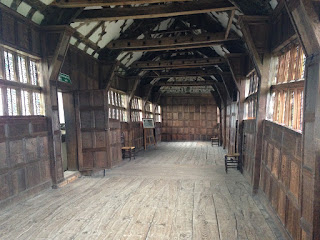I love the National Trust more than is probably advisable, but they do have a tendency to remind you on a regular basis that you are a bit of a thicko. I mean that in an affectionate way. They're like a clever uncle that always knows more than you, even when you've tried really hard to swot up on something in advance of his visit.
The Little Moreton scone
I said that the Long Gallery was my favourite room but of course that's not quite true. The tea room at Little Moreton Hall is situated in the old Tudor kitchens - I do love a tea room located in the historic building itself, although I do also love the big modern stand-alone tea rooms that you find at other properties, so the National Trust really can't lose where I am concerned.
Take Little Moreton Hall near Stoke-on-Trent. I have been a National Trust member for over two years now. I have been to 98 (NINETY-EIGHT) properties. I have a GCSE in History (I got a B). And yet the Little Moreton Hall guidebook contains at least two terms that I have NEVER, EVER heard or seen in my life before; 'chamfered pilaster' anyone? 'Bloomery'?
What made it worse was that they also used the word 'minstrel' at one point and helpfully put '(musician)' after it. I cannot be the only person who knows what a minstrel is but wouldn't know a chamfered pilaster if it hit her in the face? Anyway. Don't play Scrabble with anyone who writes National Trust guidebooks is my advice.
Let's move on, because I am doing Little Moreton Hall a massive disservice by not focusing on the charming wonkiness of their beautiful Tudor house, chamfered pilasters and all.
Here's a bit of background:
- The house was built and owned by one family throughout its history
- William Moreton I built the Great Hall in 1504-1508
- His son William Moreton II continued the work, as did his son John
- The Civil War was the undoing of the Moreton clan - William Moreton III was arrested for supporting the Monarchy and the family fell on hard times
- For 200 years the house was owned by Moretons but rented out to farmers and other tenants
- Nobody was really taking care of the building and it became neglected
- The Dale family were tenants from 1880 until 1955, by which time they were caretakers for the National Trust, who had taken ownership in 1938
The Little Moreton scone
I said that the Long Gallery was my favourite room but of course that's not quite true. The tea room at Little Moreton Hall is situated in the old Tudor kitchens - I do love a tea room located in the historic building itself, although I do also love the big modern stand-alone tea rooms that you find at other properties, so the National Trust really can't lose where I am concerned.
Anyway, the tea room was very cosy on a nippy October day and they had a good supply of scones. I split mine as usual and bit into the bottom half, which seemed a bit dry. Then I ate the top half and it was lovely. So go figure - I'm starting to wonder if I will ever truly understand scones.
I hate to finish by going on about the blooming guidebook AGAIN but I need to tell you that today I went all thoroughly modern scone blogger by buying the guide online before I set off on my trip.
I basically wanted to see if pre-reading about the place improved my visit. And I can report that in some ways it didn't help - I actually felt a bit stupid swiping through pages on my iPad trying to work out which room I was in.
But it really did make a difference in other ways. This stained glass window, for example, has a barrel (known as a tun) and a wolf with its mouth open (a mouth being known as a maw), thus making it a depiction of 'More-ton':
I would never have noticed this in a thousand years if I hadn't read the book beforehand. None of the other visitors seemed to have noticed it either, which made me feel like the cleverest person in the place. So there we have it; the National Trust might make you feel like a thicko compared to them, but read the guidebook and they make you feel very intelligent compared to everyone else.
I still don't know what a chamfered pilaster is though.
Little Moreton Hall: 5 out of 5
Scones: 4 out of 5
Likelihood of me ever knowing every word in a National Trust guidebook: 0 out of 5



No comments:
Post a Comment